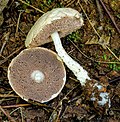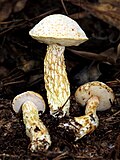| Image | Scientific name | Taxon author | Year | Distribution |
|---|
| A. albidus | Yan C. Li & Zhu L. Yang | 2021 | China (Jiangxi) |
| A. albovirescens | Yan C. Li & Zhu L. Yang | 2021 | China |
| A. amazonicus | A.M. Vasco-Pal. & C. López-Quint. | 2014 | Colombia |
| A. appendiculatus | Semwal, D. Chakr., K. Das, Indoliya, D. Chakrabarty, S. Adhikari & Karun. | 2017 | India |
 | A. asper | K. Syme, Bonito, T. Lebel, Fechner & Halling | 2020 | Queensland |
 | A. austrovirens | N.A. Fechner, Bougher, Bonito & Halling | 2017 | Queensland |
| A. brunneisquamus | N.K. Zeng, Chang Xu & S. Jiang | 2021 | China |
| A. cornalinus | (Perr.-Bertr. & R.Heim) E.Horak | 1980 | Gabon |
| A. dictyotus | (Boedijn) Wolfe | 1980 | China (Hunan) |
 | A. eburneus | Watling & N.M.Greg. | 1986 | Queensland |
| A. festivus | (Singer) Wolfe | 1980 | Brazil |
 | A. fusisporus | (Kawam. ex Imazeki & Hongo) Wolfe | 1980 | China (Yunnan) |
| A. graciliaffinis | Singer | 1988 | north of Brazil and in Colombia and Venezuela |
 | A. gracilis | (Peck) Wolfe | 1980 | Mexico to Costa Rica |
| A. heterospermus | (R.Heim & Perr.-Bertr.) Singer | 1983 | |
 | A. lacunosus (Kuntze) | T.W.May & A.E.Wood | 1995 | Australia, New caledonia and New Zealand |
| A. latitubulosus | E.Horak | 1980 | Papua New Guinea |
| A. malaccensis | (Pat. & C.F.Baker) Wolfe | 1980 | |
| A. mucosus | (Corner) Wolfe | 1980 | |
 | A. mutabilis | Halling, Osmundson & M.A. Neves | 2006 | northern Australia |
 | A. neotropicalis | Singer, J.García & L.D.Gómez | 1991 | Costa Rica |
 | A. occidentalis | Watling & N.M.Greg. | 1986 | Australia and southeastern Tasmania |
| A. olivaceobrunneus | Yan C. Li & Zhu L. Yang | 2021 | China |
| A. olivaceoglutinosus | K.Das & Dentinger | 2015 | India (Sikkim), China (Yunnan) |
| A. olivaceus | Singer | 1983 | |
| A. purpurascens | (Heinem.) E.Horak | 1980 | Zaire |
 | A. rarus | (Corner) E.Horak | 1980 | Singapore and Australia |
| A. rionegrensis | (Singer & I.J.Araujo) Singer | 1983 | Brazil. |
 | A. roseialbus | N.A. Fechner, Bonito, T. Lebel & Halling | 2017 | eastern New South Wales |
 | A. rostrupii | (Syd. & P.Syd.) E.Horak | 1980 | Thailand, Singapore |
| A. rubiicolor | (Corner) E.Horak | 1980 | Singapore |
| A. schichianus | (Teng & L.Ling) E.Horak | 1980 | China |
 | A. subflavidus | (Murrill) Wolfe | 1980 | United States(New Jersey to Florida and Texas) and Central America |
 | A. subvirens | (Hongo) Wolfe | 1980 | Japan, Papua New Guinea |
| A. trinitatensis | Wolfe | 1988 | |
 | A. tristis | (Pat. & C.F.Baker) Wolfe | 1980 | |
| A. viscidoviridis | N.A. Fechner, Bonito, T. Lebel & Halling | 2017 | Queensland |
| A. yourkae | F.E. Guard, McMull.-Fish., Van Wyk, T. Lebel & Halling | 2021 | Queensland |
|















